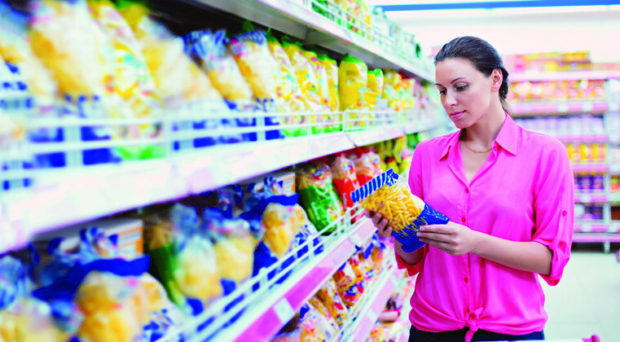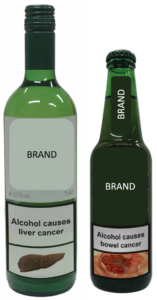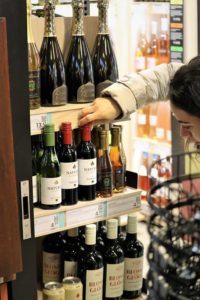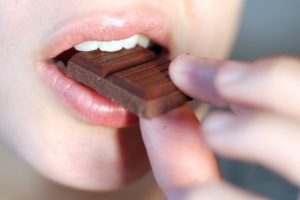
Public health bodies have suggested that tobacco-style HWLs should be considered for application to alcohol and high calorie snack products. However, evidence for their potential usefulness in these contexts is limited, with prior research typically focusing on sugary drinks, or using smaller or less representative samples. This led us to run two large-scale studies in general populations to examine the potential effectiveness and acceptability of image-and-text HWLs on alcohol and snack foods.
Our studies
In two separate online studies we asked participants to rate different image-and-text HWLs on alcoholic drinks (Alcohol study, with 5,528 participants) and energy-dense snacks (Food study, with 4,618 participants). To take part, participants for the Alcohol study had to consume either beer or wine at least once a week,  and in the Food study participants consumed biscuits, cake, crisps or chocolate at least once a week, and liked chocolate.
and in the Food study participants consumed biscuits, cake, crisps or chocolate at least once a week, and liked chocolate.
Participants viewed and rated one of 21 image-and-text HWLs on alcoholic drinks or one of 18 image-and-text HWLs on high calorie snacks. Just like on cigarette packs, the HWLs showed an image of a disease relating to excess consumption of alcohol or high calorie snacks, alongside a text warning statement. For Alcohol the diseases depicted were bowel, breast, liver and non-specified cancers, heart disease, liver cirrhosis and liver disease, while for Food, the conditions were bowel and non-specified cancers, heart disease, obesity, and type 2 diabetes.
Participants were asked how afraid, worried, uncomfortable or disgusted the label made them feel, and to rate their desire to consume the labelled product. They were also asked how strongly they supported putting the HWL on alcoholic drinks or high calorie snacks.
Results
 Alcohol study: we found that HWLs on alcoholic drinks depicting bowel cancer were associated with the highest level of negative emotional arousal and the lowest desire to consume the product. They were also considered the least acceptable for use by participants. In general, few of the alcohol HWLs were considered acceptable, with only three out of 21 rated at least somewhat acceptable.
Alcohol study: we found that HWLs on alcoholic drinks depicting bowel cancer were associated with the highest level of negative emotional arousal and the lowest desire to consume the product. They were also considered the least acceptable for use by participants. In general, few of the alcohol HWLs were considered acceptable, with only three out of 21 rated at least somewhat acceptable.
Food study: HWLs on high-density snacks depicting bowel cancer, followed by those depicting non-specific cancer, were associated with the highest level of negative emotional arousal and lowest desire to consume the product, with those depicting bowel cancer again considered to be the least acceptable. HWLs on energy-dense snacks were judged on average more acceptable than those on alcohol, with 13 out of 18 snack HWLs rated as at least somewhat acceptable.
Content analysis
We also conducted a content analysis of free-text comments that some participants provided at the end of the study. Two key themes emerged– the acceptability of HWLs on these products, and their perceived effectiveness. Within these themes, comments touched on several pertinent issues, including the believability of the labels, whether people would avoid looking at them or become desensitized to them, whether they were appropriate to use, and whether participants thought they would affect their thoughts or behaviours in relation to these products.
Overall, while a wide range of views were expressed, the majority of responses expressed negative views of the possible use of such labels. It is plausible, however, that those who chose to leave a comment at the end of the study were those with more extreme opinions.
Are our results surprising?
In terms of potential effectiveness, we found that for both alcoholic drinks and high calorie snacks, HWLs describing bowel cancer evoked the strongest negative emotional reactions and resulted in the lowest desire to consume the product they were applied to. This is consistent with previous research on alcohol labeling which has found bowel-cancer HWLs to be particularly effective. It is notable that this is similarly the case in the context of snack foods, where to our knowledge these warnings have not been tested before.
HWLs describing bowel cancer evoked the strongest negative emotional reactions
 The finding that HWLs may be judged to be relatively more acceptable to use on snack foods than on alcohol could appear surprising. This could be due to heightened public awareness of the health consequences of excess energy intake and obesity, particularly in children. The content analysis (albeit based on a small subset of participants) suggested a mainly negative reaction to these labels on these products. Again, this is perhaps not surprising given that the study sample were people who regularly consumed the target products, and interventions which affect us directly are usually less supported.
The finding that HWLs may be judged to be relatively more acceptable to use on snack foods than on alcohol could appear surprising. This could be due to heightened public awareness of the health consequences of excess energy intake and obesity, particularly in children. The content analysis (albeit based on a small subset of participants) suggested a mainly negative reaction to these labels on these products. Again, this is perhaps not surprising given that the study sample were people who regularly consumed the target products, and interventions which affect us directly are usually less supported.
Conclusions
These results suggest that labels depicting bowel cancer may have the greatest potential for reducing alcohol and snack food selection and consumption. However, while bowel cancer HWLs had the greatest impact on people, they were also rated as the least acceptable.
This study could not, however, demonstrate whether these labels are likely effective in actually changing behavior. The studies did not include a measure of actual behavior, and there was no control group to compare against. The studies were also conducted online and responses may differ when HWLs are applied to physical products in real-world settings.
Further experimental studies are now needed to directly assess the potential effectiveness of health warning labels to reduce selection and consumption of alcohol and energy-dense snacks. Studies in field and naturalistic laboratory settings will enable us to examine whether these labels are likely to be effective in real-world settings.
Comments